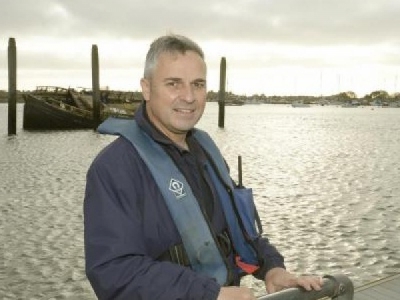
Posted on December 5, 2016
By Vicky Gayle, Gazette Standard
WITHIN a month of assuming his new role of Brightlingsea Harbour master, James Thomas will oversee a £750,000 programme at the forefront of coastal defence work.
The use of sediment as a resource is the latest European-sponsored project involving major harbour dredging and saltmarsh restoration at Cindery Island.
Phase one of the four year project will kick off soon with Brightlingsea being only one of two UK towns involved.
Costly year-round dredging is unavoidable if the harbour is to remain viable, Mr Thomas explained, but the true value of the project is an opportunity to be at the cutting-edge of sea defence by recycling leftover sediment.
Mr Thomas, 48, whose new job is as much about being the face of the harbour as the brains behind it, is raring to go.
He said: “In terms of sea defence, they are notoriously expensive.
“The way of protecting yourself is to build an enormous concrete wall which will stop the sea getting over it or you can build up a saltmarsh where vegetation will start to grow and that prolific growth, when covered with a tidal flow, is scientifically proven to slow down the rate at which the water hits the sea defence.
“What this means is the sea defence doesn’t need to be as high or thick, and it will withstand much great attrition on it.
“In comparison to potentially spending £5,000 per metre on a crest wall with no saltmarsh, it will only cost £800 in engineering the saltmarsh by putting the sediment on it and letting nature take its course.”
Brightlingsea Harbour is contributing £250,000 with the European Union’s Interreg 2 Seas Programme, part-funded by the European Regional Development Fund, fronting an estimated £500,000.
To carry out the project it is working with Exo Environmental and partnering with water authorities in the Netherlands, Belgium and France.
As well as sharing information, USAR has the added benefit of putting Brightlingsea “squarely on the map”.
Mr Thomas said: “The goal is to help us maintain the marine environment in terms of us having enough water to work with and this is an important part of that.
“It will also help put Brightlingsea on the map as a pioneering element of a scheme which will change what we do with sediment we dredge.”
To date, the harbour has functioned well and welcomes about 1,500 yachts throughout boating season from April to September.
Maintaining it requires between £700,000 and £800,000 per year, which it raises through mooring fees alongside a boat park, visitors’ fees and an operational commercial wharf run by Olivers Wharf.
Despite being self-sustaining, Mr Thomas says the harbour has enormous liabilities.
He said: “The nature of a harbour is to always plan ahead because it doesn’t follow a normal business cycle so we have to factor all these costs in.
“We need to raise more revenue and its my plan to look at alternative ways rather than sticking the prices up for the public.”
Source: Gazette Standard





